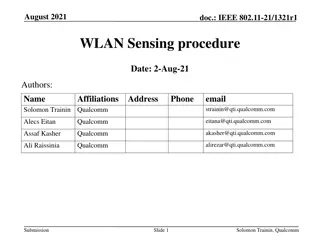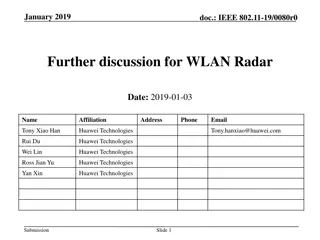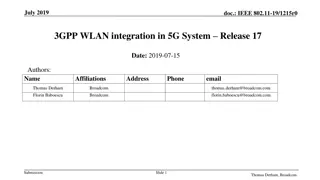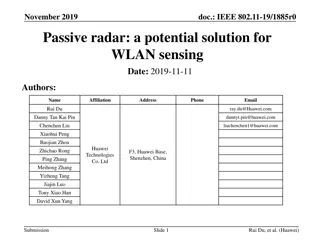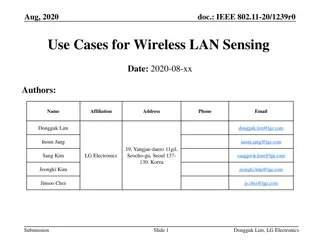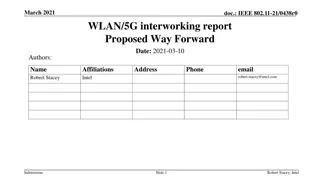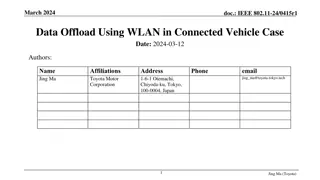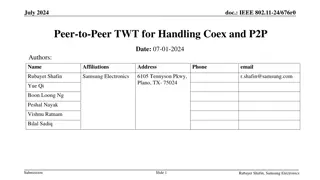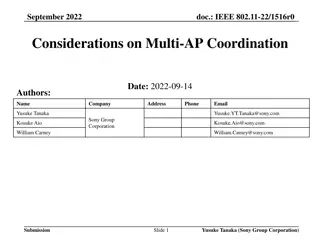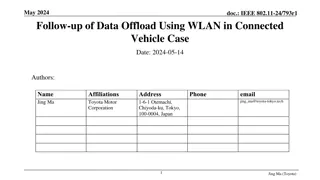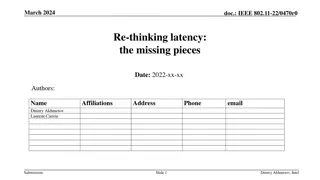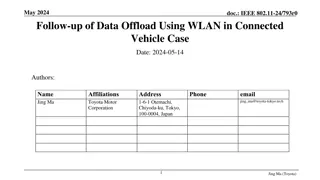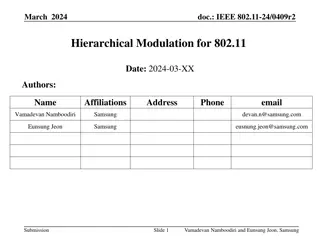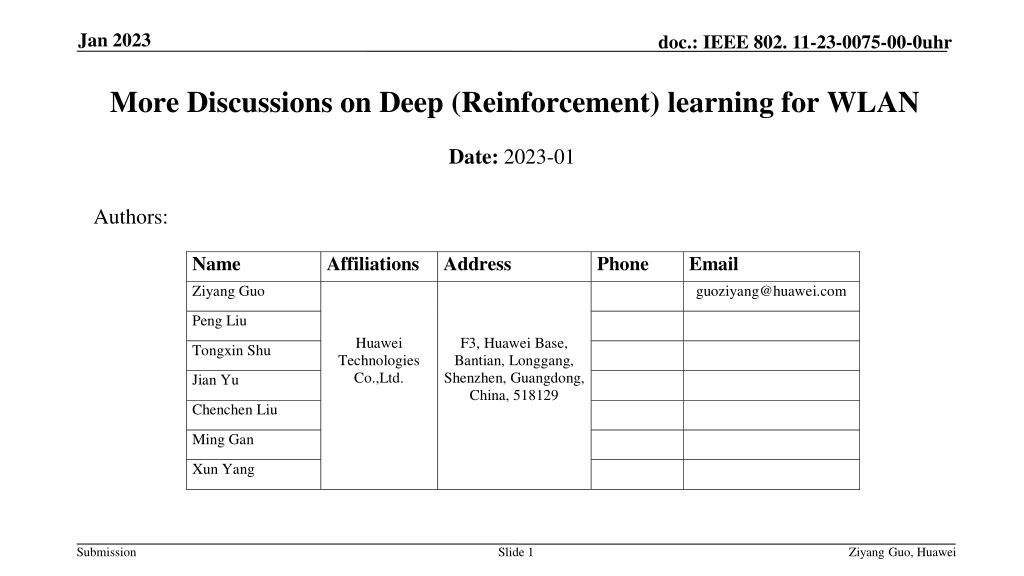
Deep Reinforcement Learning Implementation for WLAN Optimization
Explore the implementation of deep reinforcement learning in WLAN optimization for latency reduction and improved channel access. Addressed topics include neural network model deployment overhead reduction, update frequency, and legacy device performance management.
Download Presentation

Please find below an Image/Link to download the presentation.
The content on the website is provided AS IS for your information and personal use only. It may not be sold, licensed, or shared on other websites without obtaining consent from the author. Download presentation by click this link. If you encounter any issues during the download, it is possible that the publisher has removed the file from their server.
E N D
Presentation Transcript
Jan 2023 doc.: IEEE 802. 11-23-0075-00-0uhr More Discussions on Deep (Reinforcement) learning for WLAN Date: 2023-01 Authors: Name Affiliations Address Phone Email Ziyang Guo guoziyang@huawei.com Peng Liu Huawei Technologies Co.,Ltd. F3, Huawei Base, Bantian, Longgang, Shenzhen, Guangdong, China, 518129 Tongxin Shu Jian Yu Chenchen Liu Ming Gan Xun Yang Submission Slide 1 Ziyang Guo, Huawei
Jan 2023 doc.: IEEE 802. 11-23-0075-00-0uhr Introduction In previous UHR meetings, we discussed the latency sensitive use cases and latency reduction methods using machine learning techniques, especially distributed channel access using neural network [1]. In [2], we introduced a deep reinforcement learning (DRL)-based channel access scheme, showed its effectiveness on latency reduction, and discussed possible standard impacts. In [3], we addressed some questions regarding RTS/CTS, coexistence issue among AI-enabled and legacy devices, and NN model generalization. In this contribution, we discuss some general considerations on introducing neural network/deep (reinforcement) learning for WLAN. Submission Slide 2 Ziyang Guo, Huawei
Jan 2023 doc.: IEEE 802. 11-23-0075-00-0uhr Recap Standard Impact [2] Train@AP Capability AP needs training capability, ~3.24M FLOPs (n=10) Non-AP STAs need inference capability, ~9K FLOPs (~256-FFT) NN Architecture Standardized basic components Extra signaling to support more configurations Non-AP STAs > AP : Training data report Real-time report Batch report AP > non-AP STAs : NN parameter (weights and bias) deployment Unicast or broadcast to refresh NN parameters (4770 parameters, ~5KB using 8-bit quantization) AP1 AP Data report Model deployment STA3 STA 1 STA3 STA 3 Inference@STA STA3 STA 2 Historical Observations Transmit or Wait Neural Network (NN) DRL-based channel access [2]: learns the wireless environment via NN makes channel access decisions based on local observations (CCA, packet delay, ) Submission Slide 3 Ziyang Guo, Huawei
Jan 2023 doc.: IEEE 802. 11-23-0075-00-0uhr Questions Received What is the overhead of neural network model deployment? How often does the neural network model need to be updated? How to limit AI s decision and ensure less performance degradation of legacy devices? Submission Slide 4 Ziyang Guo, Huawei
Jan 2023 doc.: IEEE 802. 11-23-0075-00-0uhr Overhead Reduction for Model Deployment When introducing AI techniques in WLAN, it may involve NN model deployment, i.e., AP sends the trained NN model to non-AP STAs. It is necessary to consider the overhead reduction of model deployment. The overhead reduction can be considered from two aspects: NN model size, i.e., how large is the NN model NN model update frequency, i.e., how often does the NN model need to be updated Train@AP AP1 AP Model deployment STA3 STA 1 STA3 STA 3 Inference@STA STA3 STA 2 Submission Slide 5 Ziyang Guo, Huawei
Jan 2023 doc.: IEEE 802. 11-23-0075-00-0uhr Overhead Reduction for Model Deployment In [3], the NN model size used for DRL-based channel access is ~5KB, which is at the same level as the compressed beamforming report with BW=80MHz, Ntx=8, Nrx=2/4. Our study showed that the NN model size can be further reduced by optimizing the NN model architecture: The RNN-based architecture in [3] is replaced with a CNN-based architecture. The simulation results show that similar performance can be achieved while reducing the NN model size to ~1KB. RNN CNN Wi-Fi Submission Slide 6 Ziyang Guo, Huawei
Jan 2023 doc.: IEEE 802. 11-23-0075-00-0uhr Overhead Reduction for Model Deployment For the model update frequency, it depends on several factors: scenario, AI use cases, training accuracy, hardware limitation. In office and home scenarios, the wireless environment is quasi-static. The model update frequency can be minutes, hours, or even days. Thus, the overhead of model deployment can be negligible. Some use cases do not need frequent model learning and update, such as channel assignment and compressed CSI feedback. Other aspects such as training method/accuracy and hardware limitation are highly dependent on vendor s implementation. We suggest NN model update frequency is not regulated by standard, and is left for vendor s implementation. Submission Slide 7 Ziyang Guo, Huawei
Jan 2023 doc.: IEEE 802. 11-23-0075-00-0uhr Overhead Reduction for Model Deployment Our study showed that a well-trained NN model is able to adapt to dynamic traffic, and reduce the model update frequency. An ON-OFF traffic model (similar to NS3 network simulator) is adopted to characterize dynamic environment and evaluate the NN model robustness/generalization. NN model is trained in various traffic settings and tested in a random and dynamic setting (no further training in the testing phase). ??? ???? ON ON OFF OFF 1, ,??? ?} 1 ? ??? {??? ???? {???? , ,???? } ON-OFF traffic model: --???/????: traffic arrival rate of ON/OFF period, Poisson distributed, randomly selected from a given set -- ???/TOFF: time lasted for ON/OFF period, uniform distributed -- ON/OFF switch: linearly increase from ??? to ???? A snapshot of tested traffic Real-time throughput without online training Submission Slide 8 Ziyang Guo, Huawei
Jan 2023 doc.: IEEE 802. 11-23-0075-00-0uhr Overhead Reduction for Model Deployment From the perspective of algorithm design, more AI techniques can be investigated to improve NN model robustness/generalization, which further reduce the model update frequency, e.g., data augmentation incremental learning From the perspective of standardization, several aspects can be discussed on model deployment to reduce its overhead, e.g., trigger time, when and what event to trigger model deployment transmission duration, limit the duration of the frame containing model parameters access category/priority for model deployment frame Submission Slide 9 Ziyang Guo, Huawei
Jan 2023 doc.: IEEE 802. 11-23-0075-00-0uhr Explore Model Reuse MAC layer features, such as channel access, rate adaptation, etc., have the same goal of improving channel efficiency. The inputs of NN models are local radio measurements at PHY/MAC layer. Different features may adopt same input observations, e.g., AI-based rate selection and AI-based frame aggregation both adopt SNR and ACK as NN inputs [6]. Different features with same inputs Model architecture and/or parameter reuse can be further studied to reduce implementation complexity and facilitate standardization. Submission Slide 10 Ziyang Guo, Huawei
Jan 2023 doc.: IEEE 802. 11-23-0075-00-0uhr Filter of AI s Decision Controlled decision is important when deploying AI in real-world WLAN use cases [4-5]. Taking channel access as an example, we cannot promise that AI nodes will not "greedily" occupy the channel. A well-trained NN model can deliver good performance in most cases, but in extreme case, NN can make anomalous decisions. One possible solution is to place a filter behind the AI decision to filter out abnormal decisions. Taking channel access as an example, if the AI node "greedily" occupies the channel, it can be requested to defer for a period of time. Standard Defined Rules Filtered Action Decision Filter Historical observations Action Neural Network (NN) Moreover, to monitor and manage AI STA, we suggest to define new service/functionality in wireless network management (WNM) , e.g., NN model deployment management service, abnormal event report. Submission Slide 11 Ziyang Guo, Huawei
Jan 2023 doc.: IEEE 802. 11-23-0075-00-0uhr Aspects of Standardization NN Architecture Standardized basic components, such as DNN&CNN NN model deployment Necessary signaling Flexible model size and model update frequency to support various use cases and implementations Trigger time, transmission duration, access priority New NN model deployment service/functionality in WNM Training data report NN model operation and maintenance (O&M) Define rules to filter out abnormal decisions New service/functionality in WNM , e.g., abnormal event report Submission Slide 12 Ziyang Guo, Huawei
Jan 2023 doc.: IEEE 802. 11-23-0075-00-0uhr Summary In this contribution, we discussed some general considerations for introducing neural network/deep (reinforcement) learning in WLAN, including overhead reduction for NN model deployment, exploration of model reuse, AI decision filter and aspects of standardization. Submission Slide 13 Ziyang Guo, Huawei
Jan 2023 doc.: IEEE 802. 11-23-0075-00-0uhr Reference [1] 11-22-1519-00-0uhr-requirements-of-low-latency-in-uhr [2] 11-22-1931-00-uhr-follow-up-on-latency-reduction-with-machine-learning-techniques [3] 11-22-1942-00-aiml-follow-up-on-drl-based-channel-access [4] V. Berggren, K. Dey, J. Jeong and B. Guldogan, Bringing reinforcement learning solutions to action in telecom networks , ERICSSON BLOG, Mar 2022, https://www.ericsson.com/en/blog/2022/3/reinforcement-learning-solutions [5] D. Wu and J. Wang, Empowering the Telecommunication System with Reinforcement Learning , Samsung AI Center, Apr 2022, https://research.samsung.com/blog/Empowering_the_Telecommunication_System_with_Reinforcement_Learning [6] S. Szott, K. Kosek-Szott, P. Gaw owicz, J. Torres G mez, B. Bellalta, A. Zubow and F. Dressler, "Wi-Fi Meets ML: A Survey on Improving IEEE 802.11 Performance with Machine Learning," in IEEE Communications Surveys & Tutorials, doi: 10.1109/COMST.2022.3179242. Submission Slide 14 Ziyang Guo, Huawei

